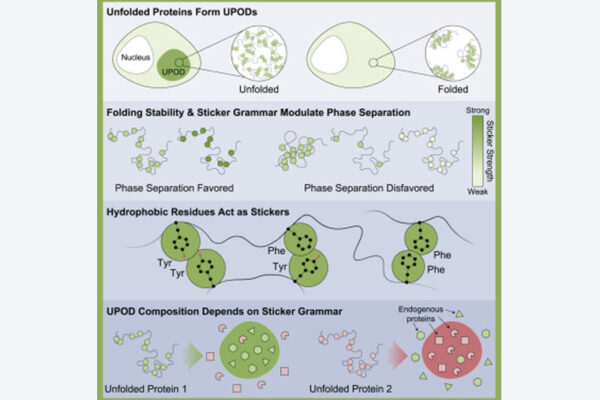Biomolecular condensates are membraneless hubs of condensed proteins and nucleic acids within cells, which researchers are realizing are tied to an increasing number of cellular processes and diseases. Studies of biomolecular condensate formation have uncovered layers of complexity, including their ability to behave like a viscoelastic material. However, the molecular basis for this putty-like property was unknown.
Through a multi-institution collaboration, researchers at Washington University in St. Louis, St. Jude Children’s Research Hospital and State University of New York at Buffalo examined the interaction networks within condensates to better define the rules associated with their unique material properties. Published in Nature Physics, the results quantify the timescales associated with these interactions, explaining why condensates act like a molecular putty and how they can “age” into a viscoelastic solid more akin to a rubber ball.
“Condensates have often been described as liquid-like, but their material properties can actually vary quite a bit,” explained Tanja Mittag, of the Department of Structural Biology at St. Jude, who collaborated on this research with WashU’s Rohit Pappu. “That depends on the sequences of the proteins within them and the lifetime of the interactions being formed.”

Pappu, the Gene K. Beare Distinguished Professor at the McKelvey School of Engineering, has been working with St. Jude and partners at Buffalo to establish how condensates act as reaction hubs to organize biomolecules in cells spatially.
Current efforts build upon years of research into the “molecular grammar” of biomolecular condensates, the rules that dictate how molecules organize themselves through the process of phase separation. The group further probed how condensates age, changing their material properties over time.
Visit the St. Jude Children’s Research Hospital website to learn more.
Alshareedah I, Borcherds WM, Cohen SR, Singh A, Posey AE, Farag M, Bremer A, Strout GW, Tomares DT, Pappu RV, Mittag T, Banerjee PR. Sequence-specific interactions determine viscoelasticity and ageing dynamics of protein condensates. Nature Physics, July 2, 2024. https://doi.org/10.1038/s41567-024-02558-1
This work was supported by the US National Institutes of Health through grants R01NS121114 (T.M. and R.V.P.), R35 GM138186 (P.R.B.) and the St. Jude Children’s Research Collaborative on the Biology and Biophysics of RNP Granules (P.R.B., T.M. and R.V.P.). S.R.C. acknowledges support from the US National Institutes of Health (T32 EB028092). We thank George Campbell from the Cell and Tissue Imaging Center at SJCRH, which is supported by SJCRH and NCI (grant P30 CA021765) for assistance with the DIC and confocal microscopy. We acknowledge the Washington University Center for Cellular Imaging (WUCCI), which is supported by the Washington University School of Medicine, The Children’s Discovery Institute of University and St. Louis Children’s Hospital (CDI-CORE-2015-505 and CDI-CORE-2019-813) and the Foundation for Barnes-Jewish Hospital (3770 and 4642).


